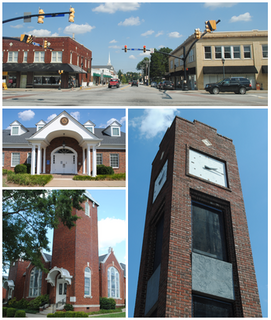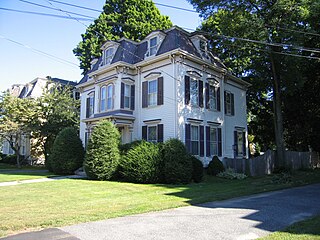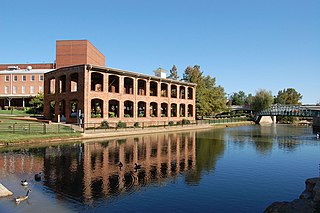
Simpsonville is a city in Greenville County, South Carolina, United States. It is part of the Greenville–Mauldin–Easley Metropolitan Statistical Area. The population was 22,234 at the 2020 census, up from 18,238 in 2010. Simpsonville is part of the "Golden Strip", along with Mauldin and Fountain Inn, an area which is noted for having low unemployment due to a diversity of industries including H.B. Fuller, KEMET, Sealed Air and Milliken.

Fountain Inn is a city in Greenville and Laurens counties in the U.S. state of South Carolina. The population was 7,799 at the 2010 census, up from 6,017 in 2000. It is part of the Greenville–Mauldin–Easley Metropolitan Statistical Area.
Interstate 385 (I-385) is an Interstate Highway located in the Upstate region of South Carolina. I-385 is a spur route of Interstate 85. The highway provides a connection between Greenville and Interstate 26 to the south, connecting Greenville to Columbia and Charleston. Around Greenville, the last several miles of I-385 forms the northeastern quadrant of a partial beltway around Greenville's southern suburbs along with Interstate 185.

Ward Parkway is a boulevard in Kansas City, Missouri, United States, near the Kansas-Missouri state line. Ward Parkway begins at Brookside Boulevard on the eastern edge of the Country Club Plaza and continues westward along Brush Creek as U.S. Route 56 until it turns southward across the creek just before the Kansas-Missouri state line. It then continues south for four miles, terminating at Wornall Road near West 95th Street.

The Perry McAdow House is a Renaissance Revival house located at 4605 Cass Avenue in Midtown Detroit, Michigan. It was designated a Michigan State Historic Site in 1976 and listed on the National Register of Historic Places in 1980.

The Clark Houses are historic houses in Natick, Massachusetts. The houses were built in 1870 and added to the National Register of Historic Places in 1978.

Heritage Square is a place in Fayetteville, North Carolina. Owned and maintained by The Woman's Club of Fayetteville, Heritage Square includes the Sandford House, built in 1797; the Oval Ballroom, a freestanding single room built in 1818; and the Baker-Haigh-Nimocks House, constructed in 1804. The buildings located on Heritage Square are listed in the National Register of Historic Places as the "Fayetteville Woman's Club and Oval Ballroom" and "Nimocks House."

The Buildings at 1200–1206 Washington Street, also known as the El Dorado Apartments and the Yellow Flats, are a historic district located in Hoboken, Hudson County, New Jersey, United States. The buildings were added to the National Register of Historic Places on March 9, 1987.

The Anna Beir House, built in 1865 by Conrad Beir, is a historic two-story redbrick house located at 214 East 4th Street in Greenville, Ohio. Miss Anna Beir was a longtime art teacher in Greenville, who devised the house to the city of Greenville upon her death in the 1930s. It was used by the Greenville Art Guild for many years until a fire in the 1970s. A gallery in the Greenville Carnegie Library is named for Miss Beir. On April 11, 1977, the house was added to the National Register of Historic Places.

Fairview Presbyterian Church is a historic church listed on the National Register of Historic Places near Fountain Inn, South Carolina. The present two-story building, constructed in 1858 in the Greek Revival style, was the fourth building constructed by the church, which was founded in 1786.

The Lend-A-Hand Club was located in downtown Davenport, Iowa, United States, along the riverfront. It was listed on the National Register of Historic Places in 1983.

Gibraltar, located at 2505 Pennsylvania Avenue in Wilmington, Delaware, is a country estate home dating from c. 1844 that is listed on the National Register of Historic Places. It takes its name from the Rock of Gibraltar, alluding to the high rocky outcrop on which the house was built. It is located just inside Wilmington's city limits and originally stood at the center of a much larger estate which has over time been reduced to the present area of about a city block in size. The house was originally built by John Rodney Brincklé and inherited by his brother's wife and children, before being bought in 1909 by Hugh Rodney Sharp, who was linked to the Du Pont family through marriage and work. Sharp expanded and remodeled the house, as well as commissioning the pioneering female landscape designer Marian Cruger Coffin to lay out the gardens.

Isaqueena, also known as the Gassaway Mansion, is a historic house in Greenville, South Carolina, and the largest private residence in the Upstate. In 1982 it was listed in the National Register of Historic Places.

Earle Town House is a historic house in Greenville, South Carolina. It was listed in the National Register of Historic Places on August 5, 1969, and is included in the Col. Elias Earle Historic District.

Harmony Hall, also known as the Peebles House, is a historic building located at 109 East King Street in Kinston, North Carolina, United States. The 18th-century house, the oldest building in Kinston, was owned by North Carolina's first elected governor. The house briefly served as the de facto state capitol during the Revolutionary War. The building has been expanded and renovated throughout its history, transitioning from the Georgian and Federal styles to Greek Revival. One of the prominent features of the house is the two-story porch on the facade. Harmony Hall was added to the National Register of Historic Places (NRHP) in 1971 and serves as a house museum operated by the Lenoir County Historical Association.

The Wilkins House is a historic house in Greenville, South Carolina, built in 1878 by Jacob W. Cagle (1832–1910) for merchant and capitalist William T. Wilkins (1825–1895). It was listed on the National Register of Historic Places on July 19, 2016.

William H. Long House is a historic home located at Greenville, Pitt County, North Carolina. It was built in 1917–1918, and is a two-story, brick veneer dwelling with Classical Revival style design elements. It a hipped roof intersected by gable roofed wings on the back and sides. It features a monumental pedimented portico and porte cochere supported by paired Tuscan order columns. It was built by William Henry Long (1866–1920), who served as mayor of Greenville from 1901 to 1903. It was renovated about 1980 to house law offices.

The James A. Fulmer House is a historic house at 303 North Main Street in Fountain Inn, South Carolina. It is a 1+1⁄2 story brick building, with a side gable roof and projecting gable section on the left front. It is basically Tudor Revival in character, but also exhibits Craftsman details such as extended eaves and exposed rafter ends. Built in 1932 for a prominent businessman, it is one of the city's finest examples of Tudor Revival architecture, and a rare example of design work by Leila Ross Wilburn, one of the first female pattern-book architects.
Edward McClaren was an American physician in South Carolina. McClaren is best known for founding a hospital to treat African-American patients during the late Jim Crow Era. The building that housed the hospital is now slated for preservation, and McClaren's name will adorn a new development.

The Wyche Pavilion is the two-story, open-air shell of a historic building in downtown Greenville, South Carolina, used in the 21st century as an event venue. As part of the Reedy River Industrial District, the building was listed in the National Register of Historic Places on January 14, 1979.






















